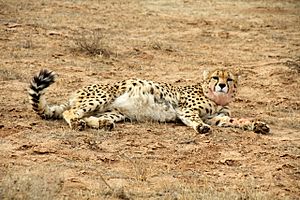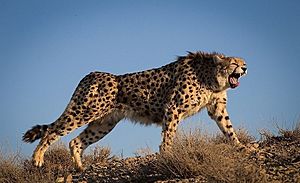Asiatic Cheetah facts for kids
Quick facts for kids Asiatic Cheetah |
|
|---|---|
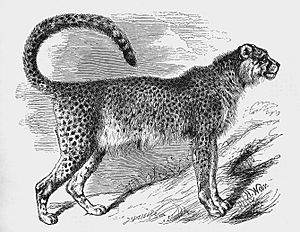 |
|
| Portrait of an Asiatic Cheetah from India | |
| Conservation status | |
| Scientific classification | |
| Kingdom: | |
| Phylum: | |
| Class: | |
| Order: | |
| Family: | |
| Genus: | |
| Species: | |
| Subspecies: |
A. j. venaticus
|
| Trinomial name | |
| Acinonyx jubatus venaticus (Griffith, 1821)
|
|
| Synonyms | |
|
Acinonyx jubatus raddei |
|
The Asiatic Cheetah (Acinonyx jubatus venaticus) is a subspecies of the cheetah. It is also called the Iranian Cheetah because the only living Asiatic cheetahs live in Iran. Even though it is extinct in India, it is sometimes called the Indian Cheetah. During British colonial times in India it was famous by the name of Hunting-Leopard. This name came about because some of these animals were kept captive by Indian royalty and used to hunt wild antelopes.
Contents
Characteristics
The Asiatic cheetah has a buff- to light fawn-coloured fur that is paler on the sides, on the front of the muzzle, below the eyes and inner legs. Small black spots are arranged in lines on the head and nape, but irregularly scattered on body, legs, paws and tail. The tail tip has black stripes. The coat and mane are shorter than of African cheetah subspecies. The head and body of an adult Asiatic cheetah measure about 112–135 cm (44–53 in) with a 66–84 cm (26–33 in) long tail. It weighs about 34–54 kg (75–119 lb). Males are slightly larger than the females.
The cheetah is the fastest land animal in the world. It was previously thought that the body temperature of a cheetah increases during a hunt due to high metabolic activity. In a short period of time during a chase, a cheetah may produce 60 times more heat than at rest, with much of the heat, produced from glycolysis, stored to possibly raise the body temperature. The claim was supported by data from experiments in which two cheetahs ran on a treadmill for minutes on end but contradicted by studies in natural settings, which indicate that body temperature stays relatively the same during a hunt. A 2013 study suggested stress hyperthermia and a slight increase in body temperature after a hunt. The cheetah's nervousness after a hunt may induce stress hyperthermia, which involves high sympathetic nervous activity and raises the body temperature. After a hunt, the risk of another predator taking its kill is great, and the cheetah is on high alert and stressed. The increased sympathetic activity prepares the cheetah's body to run when another predator approaches. In the 2013 study, even the cheetah that did not chase the prey experienced an increase in body temperature once the prey was caught, showing increased sympathetic activity.
Distribution and habitat
The cheetah thrives in open lands, small plains, semi-desert areas, and other open habitats where prey is available. The Asiatic cheetah mainly inhabits the desert areas around Dasht-e Kavir in the eastern half of Iran, including parts of the Kerman, Khorasan, Semnan, Yazd, Tehran, and Markazi provinces. Most live in five protected areas, viz Kavir National Park, Touran National Park, Bafq Protected Area, Dar-e Anjir Wildlife Refuge, and Naybandan Wildlife Reserve.
During the 1970s, the Asiatic cheetah population in Iran was estimated to number about 200 individuals in 11 protected areas. By the end of the 1990s, the population was estimated at 50 to 100 individuals. During camera-trapping surveys conducted across 18 protected areas between 2001 and 2012, a total of 82 individuals in 15–17 families were recorded and identified. Of these, only six individuals were recorded for more than three years. In this period, 42 cheetahs died due to poaching, in road accidents and due to natural causes. Populations are fragmented and known to survive in the Semnan, North Khorasan, South Khorasan, Yazd, Esfahan, and Kerman Provinces.
Ecology and behaviour
Most sightings of cheetahs in the Miandasht Wildlife Refuge between January 2003 and March 2006 occurred during the day and near watercourses. These observations suggest that they are most active when their prey is.
Camera-trapping data obtained between 2009 and 2011 indicate that some cheetahs travel long distances. A female was recorded in two protected areas that are about 150 km (93 mi) apart and intersected by railway and two highways. Her three male siblings and a different adult male were recorded in three reserves, indicating that they have large home ranges.
Diet
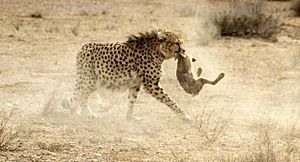
The Asiatic cheetah preys on medium-sized herbivores including chinkara, goitered gazelle, wild sheep, wild goat and cape hare. In Khar Turan National Park, cheetahs use a wide range of habitats, but prefer areas close to water sources. This habitat overlaps to 61% with wild sheep, 36% with onager, and 30% with gazelle.
In India, prey was formerly abundant. Before its extinction in the country, the cheetah fed on the blackbuck, the chinkara, and sometimes the chital and the nilgai.
Reproduction

Evidence of females successfully raising cubs is very rare. A few observations in Iran indicate that they give birth throughout the year to one to four cubs. In April 2003, four cubs found in a den had still closed eyes. In November 2004, a cub was recorded by a camera-trap that was about 6–8 months old. Breeding success depends on availability of prey. In October 2013, a female with four cubs were filmed in Khar Turan National Park. In December 2014, four cheetahs were sighted and photographed by camera traps in the same national park. In January 2015, three other adult Asiatic cheetahs and a female with her cub were sighted in Miandasht Wildlife Refuge. Eleven cheetahs were also sighted at the time, and another four a month later. In July 2015, five adult cheetahs and three cubs were spotted in Khar Turan National Park.
Threats
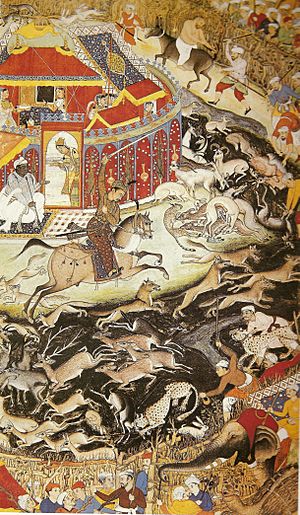
The Asiatic cheetah has been listed as Critically Endangered on the IUCN Red List since 1996. Following the Iranian Revolution of 1979, wildlife conservation was interrupted for several years. Manoeuvres with armed vehicles were carried in steppes, and local people hunted cheetahs and prey species unchecked. The gazelle population declined in many areas, and cheetahs retreated to remote mountainous habitats.
Reduced gazelle numbers, persecution, land-use change, habitat degradation and fragmentation, and desertification contributed to the decline of the cheetah population. The cheetah is affected by loss of prey as a result of antelope hunting and overgrazing from introduced livestock. Its prey was pushed out as herders entered game reserves with their herds. A herder pursued a female cheetah with two cubs on his motorbike, until one of the cubs was so exhausted that it collapsed. He caught and kept it chained in his home for two weeks, until it was rescued by officers of the Iranian Department of Environment.
Mining development and road construction near reserves also threaten the population. Coal, copper, and iron have been mined in cheetah habitat in three different regions in central and eastern Iran. It is estimated that the two regions for coal (Nayband) and iron (Bafq) have the largest cheetah population outside protected areas. Mining itself is not a direct threat to the population; road construction and the resulting traffic have made the cheetah accessible to humans, including poachers.
Conservation efforts

In September 2001, the project "Conservation of the Asiatic Cheetah and its Associated Biota" was launched by the Iranian Department of Environment in cooperation with the United Nations Development Programme's Global Environment Facility, the Wildlife Conservation Society, the IUCN Cat Specialist Group, the Cheetah Conservation Fund and the Iranian Cheetah Society.
Personnel of Wildlife Conservation Society and the Iranian Department of Environment started radio-collaring Asiatic cheetahs in February 2007. The cats' movements are monitored using GPS collars. International sanctions have made some projects, such as obtaining camera traps, difficult.
A few orphaned cubs have been raised in captivity, such as Marita who died at the age of nine years in 2003. Beginning in 2006, the day of his death, 31 August, became the Cheetah Conservation Day, used to inform the public about conservation programs.
In 2014, the Iranian national football team announced that their 2014 FIFA World Cup and 2015 AFC Asian Cup kits are imprinted with pictures of the Asiatic cheetah in order to bring attention to conservation efforts. In February 2015, Iran launched a search engine, Yooz, that features a cheetah as logo. In May 2015, the Iranian Department of Environment announced plans to quintuple the penalty for poaching a cheetah to 100 million tomans (around US$2500 as of February 2022). In September 2015, Meraj Airlines introduced the new livery of Iranian Cheetah to support its conservation efforts. Iranian officials have discussed constructing wildlife crossings to reduce the number of deaths in traffic accidents.
Related pages
Images for kids
See also
 In Spanish: Guepardo asiático para niños
In Spanish: Guepardo asiático para niños



